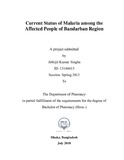Current status of malaria among the affected people of Bandarban region

View/Open
Date
2018-07Publisher
BRAC UniversityAuthor
Singha, Abhijit KumarMetadata
Show full item recordAbstract
Malaria is still considered a public health problem of Bangladesh by the World Health
Organization. Among 13 vulnerable districts of Bangladesh, 3 hill districts are highly affected by
this disease. Malaria-infected people from Bandarban pouroshova, Thanchi bazar and their nearby
areas (samples, n=144) were questioned at random to understand the present situation. Obtained
data were analyzed by SPSS software. The study investigated the age group and gender who were
infected by malaria, most used treatment type, infection causes, duration of illness, malaria
knowledge, initiation of treatment after malaria infection etc. Delayed Seeking for treatment is the
most common scenario among hill-tribes. 90.3% of infected people knew about the symptoms of
malaria, 46.5% knew about the waterborne disease, 93.8% of infected people know that what the
causes of malaria are. Most of the samples get information from NGO who are doing a remarkable
job in this sector. They have a separate unit for malaria prevention in each of their regional offices.
People of these regions know about Malaria and other related information. A reduction of more
than 50% in malaria cases and 54% in related deaths since 2010. Though the infection reduction
rate is satisfactory, the malaria cases in Bandarban are fluctuating and still need to be dealt with
care.
